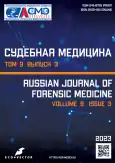Forensic medical cytological examination of the trace evidence on the knife’s blade in the case of multiple penetrating stab/cut wounds in the chest with lung damage: a case report
- Authors: Kidralieva A.P.1, Fedorovtsev A.L.2, Kidraliev R.R.1
-
Affiliations:
- Irkutsk regional Bureau of forensic medical examination
- Nizhny Novgorod regional Bureau of forensic medical examination
- Issue: Vol 9, No 3 (2023)
- Pages: 349-354
- Section: Case reports
- URL: https://journals.rcsi.science/2411-8729/article/view/148363
- DOI: https://doi.org/10.17816/fm12232
- ID: 148363
Cite item
Full Text
Abstract
Various trace evidence are often found on the instruments of mechanical injury, including microparticles of human’s damaged organs and tissues. The detection of cells and microparticles of organs and tissues on the instrument of injury confirms its contact with the human body, which is of great evidentiary value.
The article presents the results of forensic medical cytological examination of biological evidence taken from the knife’s blade in the case of multiple penetrating stab/cut wounds in the chest that result in lung damage. Microscopic preparations were made from the traces on knife’s blade, which were stained with fluorochrome solutions (0.0005% aqueous solution of atebrine and 0.01% solution of acridine orange). The study was performed using the luminescent microscope Leica DM2500 (20× and 60× lenses, 10× eyepiece). The examination of microparticles of the striated skeletal muscle revealed areolar connective and fat tissues with capillary and arteriole fragments. The isolated mesothelial cells and type II pneumonocytes were also detected. Fibers of the striated skeletal muscle tissue looked like long multinucleated cells with distinguishing cross-striation. The areolar connective tissue was represented by loosely arranged fibers embedded in the ground substance. Fragments of the fat tissue looked like the clusters of round and oval large cells, tightly pressed together, with capillaries, and arterioles in between. Y-chromatin was detected in the nuclei of most cells. In addition, human blood was found on the knife’s blade.
Thus, the study revealed that tiny particles of tissues and isolated human cells of the male genetic sex were detected, their organ–tissue affiliation was established, which is a valuable diagnostic finding, because it confirms the contact of the trauma instrument with the human body.
Full Text
##article.viewOnOriginalSite##About the authors
Anna P. Kidralieva
Irkutsk regional Bureau of forensic medical examination
Author for correspondence.
Email: chetvertnova2011@yandex.ru
ORCID iD: 0000-0002-4786-1065
SPIN-code: 5968-6328
MD, Cand. Sci. (Med.)
Russian Federation, IrkutskAndrey L. Fedorovtsev
Nizhny Novgorod regional Bureau of forensic medical examination
Email: afedorovtsev@yandex.ru
ORCID iD: 0000-0002-6281-4689
SPIN-code: 1516-0318
MD, Dr. Sci. (Med.)
Russian Federation, Nizhny NovgorodRuslan R. Kidraliev
Irkutsk regional Bureau of forensic medical examination
Email: rustemovitch@mail.ru
ORCID iD: 0009-0002-3243-0710
SPIN-code: 8943-1221
MD, Cand. Sci. (Med.)
Russian Federation, IrkutskReferences
- Fedorovtsev AL, Rеvnitskaya LA, Koroleva EI, Edelev NS. Forensic cytological examination of traces on physical evidence. Nizhny Novgorod; 2009. 152 p. (In Russ).
- Dettmeyer RB. Forensic Cytology. In: Forensic Histopathology: Fundamentals and Perspectives. Springer; 2018. P. 493–502. doi: 10.1007/978-3-319-77997-3-18
- Ateriya N, Saraf А, Shedge R, et al. Techniques in forensic cytology: The road ahead. J Indian Acad Forensic Med. 2019;41(1):63–70. doi: 10.5958/0974 0848.2019.00016.2
- Fedorovtsev AL, Koroleva EI, Rеvnitskaya LA. Diagnostic significance of detection of human’s body tissues micro particles on mechanical trauma instruments. Bulletin Forensic Med. 2012;(1):34–38. (In Russ).
- Fedorovtsev AL, Koroleva EI. Detection of lung tissue cells in traces-overlays on piercing and cutting tools. Forensic Med Examinat. 1990;(4):58–59. (In Russ).
- Zagryadskaya AP, Koroleva EI, Fedorovtsev AL. About cytological examination of organs and tissues identified in traces, overlays on trauma instruments. In: Modern scientific and practical developments of forensic doctors in Mordovia: А collection of scientific and practical works. Issue 3. Saransk; 2001. (In Russ).
- Bhardwaj N, Nangia R, Puri A, et al. Determination of gender from dental pulp by identification of Barr bodies: A comparative study. J Oral Maxillofac Pathol. 2022;26(4):488–494. doi: 10.4103/jomfp.jomfp_250_22
- Datar U, Angadi PV, Hallikerimath S, Kale AD. Cytological assessment of Barr bodies using aceto-orcein and papanicolaou stains in buccal mucosal smears and their sex estimation efficacy in an Indian sample. Acta Cytol. 2013;57(5):516–521. doi: 10.1159/000353216
- Reddy DS, Sherlin HJ, Ramani P, Prakash PA. Determination of sex by exfoliative cytology using acridine orange confocal microscopy: A short study. J Forensic Dent Sci. 2012;4(2):66–69. doi: 10.4103/0975-1475.109887
- Tishinova LA, Fedorovtsev AL. Determination of mixed traces of blood and cells on the blade of a knife in cases of injury to several victims. Forensic Med Examinat. 1998;(6):23–24. (In Russ).
- Fedorovtsev AL. Traces-overlays on tools of mechanical trauma as a source of identification information. Forensic Med Examinat. 1997;(2):20–21. (In Russ).
- Fedorovtsev AL, Edelev NS, Rеvnitskaya LA, Koroleva EI. The current state of the issue of the study of traces-overlays on the instruments of traumay. In: Materials of the VI All-Russian Congress of Forensic doctors: А collection of scientific and practical works. Moscow-Tyumen; 2005. (In Russ).
Supplementary files







